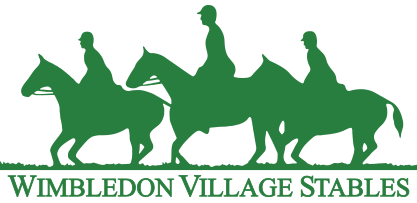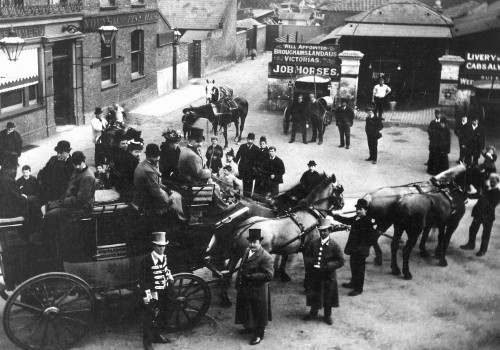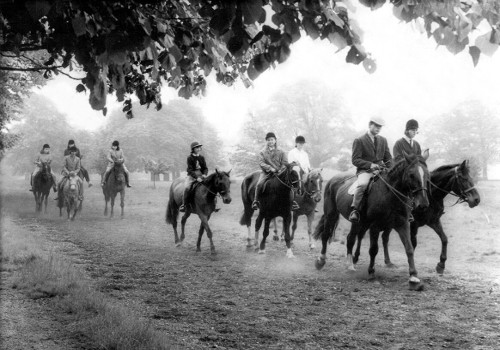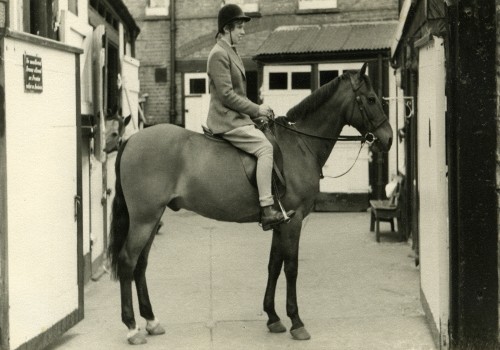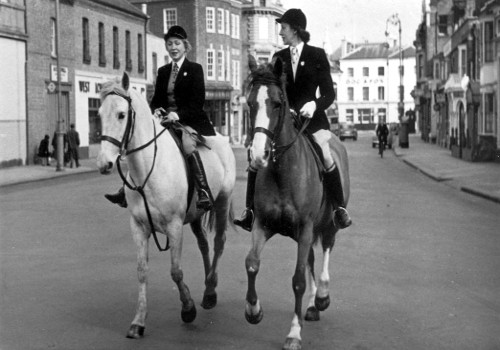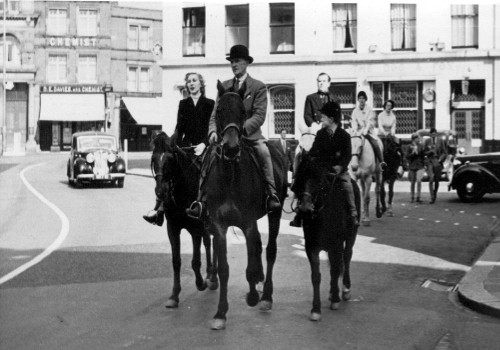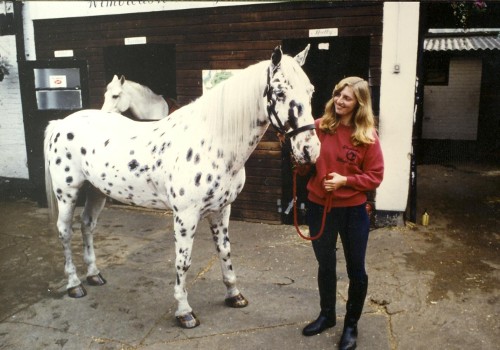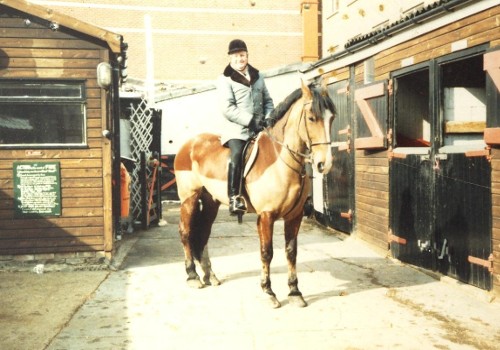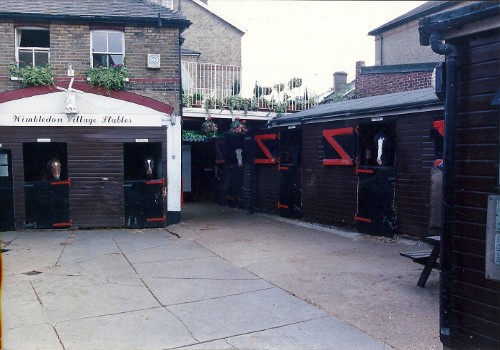In SW19 since 1919 - The fascinating history of Wimbledon Village Stables
We believe we are the oldest recorded riding stables in England. The late Richard Milward MA, a renowned local historian, researched the background of horses in Wimbledon over the years and found that the first recorded stables belonged to the Lord of the Manor, and are detailed in the Estate’s accounts of 1236-37.
The stables on our current site, behind the Dog & Fox pub in the High Street, were founded in 1919 by William Kirkpatrick and named Hilcote Stables; William’s daughter Jean took over on his retirement and continued to visit the stables until her death in 2005. From 1969, Hilcote Stables was leased to Colin Crawford, and when it came up for sale in 1980 and was bought by the current owner, Carol Andrews, it was renamed Wimbledon Village Stables.
We often welcome visitors into the yard who have very fond memories of the stables from years ago, and we always love to hear their stories. Riding here has obviously had a huge impact on so many people, and continues to do so to this day.
Wimbledon’s first recorded horses in fact appear in the reign of King John’s son, Henry III. They belonged to the lord of the manor, the Archbishop of Canterbury. In his accounts for the years 1236-37, the Archbishop’s Bailiff (the official who managed his farm at the end of Church Road near St Mary’s) noted that he had two horses.
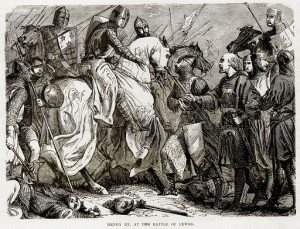 The accounts for the 1270s show that the Bailiffs example had since been followed by some of the Archbishop’s tenants who now also owned horses. Instead of doing work in his fields, they were paying rent for their land not in money, but in horseshoes or in “strigils”, curry combs for grooming horses. So there is little doubt that they were already grazing their one or two animals on the Common. Then John Perkyn was fined for “overburdening the Common with six horses and mares”, four more than he was allowed. In 1488, all the tenants were ordered “to remove from the Common all mangy horses and mares”, an order often repeated in the next century.
The accounts for the 1270s show that the Bailiffs example had since been followed by some of the Archbishop’s tenants who now also owned horses. Instead of doing work in his fields, they were paying rent for their land not in money, but in horseshoes or in “strigils”, curry combs for grooming horses. So there is little doubt that they were already grazing their one or two animals on the Common. Then John Perkyn was fined for “overburdening the Common with six horses and mares”, four more than he was allowed. In 1488, all the tenants were ordered “to remove from the Common all mangy horses and mares”, an order often repeated in the next century.
By then stables and coaches had begun to appear at the chief houses in the village. In the 1550s William Cecil had a stable at the Rectory capable of taking 14 horses. By the early years of the next century his eldest son, Thomas first Earl of Exeter and builder of Wimbledon’s first manor house, owned several coaches, while his grandson, Edward, Viscount Wimbledon, escorted the coffin of his second wife to St Mary’s parish church “by night with a train of twenty carriages, drawn with six horses a piece and many more with four, and with torches without number”. It must have been an amazing sight.
Riders on the Common
As the numbers of such wealthy families living in Wimbledon increased, so their journeys to London on horseback or by coach became tempting targets for footpads and highwaymen. In the 1750s such robbers were said to “so infest” the Common “that ’tis dangerous travelling day or night”.
In the 1730s, it was the scene of an annual horse race for the King’s Plate. Sixty years later, during
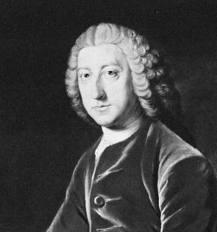
William Pitt
the long war against Napoleon, it was also the training ground of a mounted “Home Guard”, the Wimbledon Volunteer Cavalry who, in colourful uniforms, paraded twice a week to prepare for a French invasion which fortunately never came.
By then, with the threat from highwaymen at last over, the Common was being used by riders whose chief interest was not travel, but exercise. Among them was the Prime Minister, William Pitt, who on his frequent visits to Cannizaro in the 1790s went for long rides with his host, Henry Dundas, the Secretary for War.
Village Blacksmith and Stables
The men who had the important job of caring for all these horses, those of the wealthy gentry as well as of the ordinary villagers, were the blacksmiths. The first whose name has been recorded was John Linton in 1617. His smithy was at “Long’s Corner” where the High Street joins Southside (and where today, very appropriately, the vet has his surgery). Not merely did he shoe horses, but like a vet tried to cure their ailments, as well as repairing ploughs and carts, and making farm implements.
Linton seems to have been law abiding, but one of his successors in Charles II’s reign, Tobias Barton, was frequently in trouble, accused of being “a common disturber of the peace” and “throwing a large quantity of dung into le Pond”. Nevertheless, the smithy remained at Long’s Corner until well into the twentieth century, while the blacksmiths from early in Queen Victoria’s reign began to describe themselves as “Smiths, Farriers and Vets”.
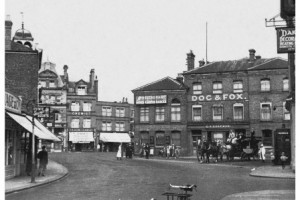 All this time an increasing number of travellers had been passing through the village, especially after Putney Bridge was opened in 1729. To look after those who needed to stay the night, there were two main inns: the older Dog and Fox, and the Rose and Crown. Each had large stables for the horses. By the 1850s, these were being called livery stables (able to look after other horses than those of people lodging at the inn) and were run by a Job Master (ready to provide horses for hire).
All this time an increasing number of travellers had been passing through the village, especially after Putney Bridge was opened in 1729. To look after those who needed to stay the night, there were two main inns: the older Dog and Fox, and the Rose and Crown. Each had large stables for the horses. By the 1850s, these were being called livery stables (able to look after other horses than those of people lodging at the inn) and were run by a Job Master (ready to provide horses for hire).
The Harris Family Enterprise
The early 20th century saw the Harris family significantly contribute to Wimbledon’s equestrian history. Charles Henry Harris, originally a surgeon’s assistant, became a Job Master while living in Denmark Avenue in 1901. His brother John Delavil Johnstone Harris, a surgeon in Linslade, Leighton Buzzard, also became involved in equestrian enterprises in Wimbledon.
By 1908, Eustace de Mendes Harris managed the Dog and Fox stables and oversaw operations at the Old Swan Yard, Ridgway. Eustace, a former Mountie in Canada and Boer War veteran, brought extensive experience with horses. Harold George Harris, John’s son, joined the family business by 1910, working as a Job Master and boarding in Church Road.
John Harris’s electoral register entries from 1913 to 1915 list him as responsible for the Dog and Fox Livery Yard and the Swan Livery Yard. These properties, central to the family’s operations, likely continued under Harold’s management during World War I, despite the requisitioning of horses for military service
The Harris family’s contributions to Wimbledon’s equestrian heritage are a testament to their ingenuity and adaptability. Their story enriches the broader history of the village, highlighting the vital role stables and horses played in the community’s development. Today, these tales connect us to a rich tradition of horsemanship that continues to thrive in Wimbledon.
Wimbledon’s First Riding Stables
The first person in Wimbledon to give riding lessons seems to have been William Cooke, who had recently been managing Astley’s famous circus near Westminster Bridge. He came here in 1866, took over the stables next to the Castle Inn in Church Road and advertised himself as Riding and Job Master.
When he died twenty years later, his son, also William, took over. Just before the First World War he transformed the stables into the Victoria Riding Establishment. Unfortunately his horses were then requisitioned by the Government for war service.
The Wimbledon Museum is a small, intimate museum where you will find, in pictures, words and objects, the 3000 year history of Wimbledon. 22 Ridgway, Wimbledon, London SW19 4QN. It is open at the weekend between 2.30pm and 5pm, admission is free.
Hilcote Riding School
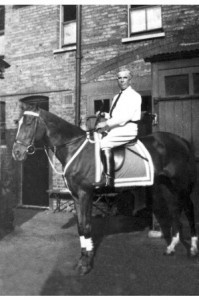
William Kirkpatrick
The next recorded instructor was William Kirkpatrick, a Scotsman who trained racehorses for a wealthy banker. When his employer moved to London during the First World War, Kirkpatrick came with him, but soon came to believe that the future lay with riding rather than racing stables. So he gave up his job, moved to Wimbledon, leased a house at the end of Marryat Road and started a small riding stables. Shortly afterwards the much larger and more central Stables behind the Dog and Fox came on the market. He decided to take on the lease and there in 1919 set up the Hilcote Riding School, (now Wimbledon Village Stables) named apparently after the lady owner’s house in Lancaster Road.
The School was a success almost from the start. Mr Kirkpatrick did the instructing, helped at first by his brother (who then left and took over William Cooke’s old stables near the Castle Inn). He had a large staff of grooms, all men, and kept 35 to 40 horses in two stables. The main one was behind the Dog and Fox; a smaller one for the children’s ponies was some distance away in a mews opposite Grosvenor Hill. The horses were bought at Tattersall’s auctions in London or at Cambridge horse sales. They cost between sixty and eighty pounds each and had a normal working life of ten years. Every four weeks, grooms rode them down the Hill to the blacksmith’s in St Mark’s Place, near the library, to be shod.
Riders came in large numbers. Many were small boys and girls who paid five shillings an hour and were instructed in two riding rings, the Black Ring near the Roman Well Laundry on the Common and the Sandy Ring near the Richardson Evans Playing Fields by the Robin Hood Gate to Richmond Park. But the great majority of the riders were men, often wealthy businessmen like Richard Seligman of Lincoln House, Parkside, and Alfred Faulkner, a tobacco “baron” who owned a huge house a little nearer Putney. Such people had the horses brought to their house by one of the grooms. Even more select was Roy Lancaster, head of the “Pru”. He owned a coach and four, which was looked after by the Stables and kept in a nearby garage. Every summer he took it out and drove to Epsom for the races.
The outbreak of the Second World War in 1939 nearly ruined Hilcote Riding School. The horses were not requisitioned as in 1914, but the number of people wanting to ride shrank, especially at the time of the Battle of Britain and there was a constant problem of getting enough food for the horses. Their survival was ensured by the Stables agreeing to look after the Carleton Bakery horses,
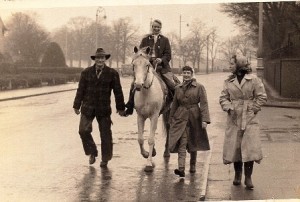
Cal McCord
which gained them horse feed from a corn merchant on Wimbledon Hill, as well as pigswill collected from bins at street corners.
Later, as the threat of raids receded (and the Morrison shelter in the saddle room was no longer needed), the Stables gained new customers, American officers preparing for the invasion of Europe. Among them was the famous cowboy, Cal McCord, who rode regularly on the Common.
After the War, the Stables soon revived. But then William Kirkpatrick died and his daughter Jean, who had already taken over, had a serious riding accident. Confined to a wheelchair she continued to supervise the running of the stables from the office, and even managed to do some teaching aided by a carer and with the help of a car.

In 1964 in stepped Colin Crawford, a local businessman, known jokingly as ‘The Squire of Wimbledon’ who at first just liveried a pony called ‘Lucky Jimmy’ for his son Keith to learn to ride on. Having ridden throughout his life, he then bought a horse for himself, ‘Melody Fair’, a beautiful skewbald mare. Unknowingly, this would change the long term course of his life and the stables once again.
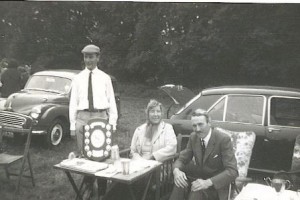
Colin Crawford, Jean Kirkpatrick and Michael Simons MRCVS
By the end of the Sixties, Colin was virtually overseeing the day to day running of the stables. Jean Kirkpatrick, although mentally a resoundingly strong woman, found it difficult to run the stables alone. Colin by now had his mare, Melody Fair plus Lucky Jimmy’s replacement Nobby a thirty five year old pony he bought for £60 in 1965 for his daughter Jenny to learn to ride on. With Lucky Jimmy being retired through laminitis, Keith and Jenny shared Nobby between them. Every free moment was spent at the stables or going to shows.
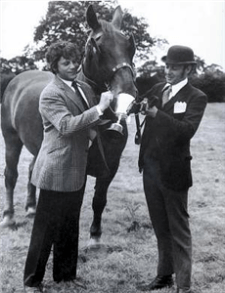
Oliver Reed
By 1969 Colin’s own first marriage had broken down; coincidentally, around this time the family linen business in Ireland was sold. Free to do what he liked, Colin agreed to take over the lease and running of the stables full time. The actor Oliver Reed, a good friend of Colin’s, kept his horse Dougal at livery at the yard. Colin met his second wife, Judith a cousin of Oliver’s through Dougal. Judith would come up occasionally to ride him. ‘The Squire’ was a good looking chap to whom Judith took a shine. Sharing a passion for horses, they later married in 1972.
Throughout the early 70s Jean continued to live with her carer in the flat above the yard till the mid seventies when she sadly had to move into assisted housing because of her paralysis. Colin had tried to purchase the stables outright from Jean throughout this time, but to no avail: Jean would not sell.
In 1978, Colin and Judith wanted to purchase their own stables, and so bought ‘April Cottage’ in Walton on the Hill, complete with a yard comprising thirty-plus boxes and some land. Colin by this time was tiring of life in Wimbledon and was happy to move. He was more content out on the hunting field anyway. A full member of the Surrey Union Hunt, Saturday and Wednesday would find him at full hue and cry, usually taking the odd hireling or two along for the thrill. Having lived a long time at Wimbledon, they sold their house off the Ridgway and moved to Surrey. Having both yards during 1979 proved to be too much, although they had installed a manager at Hilcote, things just weren’t the same.
By the end of the year Colin had totally lost interest and decided to give Hilcote up to concentrate full-time on his new yard. It was to be ironic, that, having declared for years that she wouldn’t sell the yard, with Colin now gone, Jean Kirkpatrick did exactly that. She put the stables on the market.
The New Wimbledon Village Stables
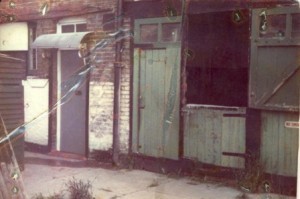 In December 1979, the yard was put up for sale. Aylesford, who was asked to manage it, stated at first: “We are not exactly sure how to value the site. It’s not every day that a stables comes up for sale”. However, by the start of 1980 it was put on the market, though Aylsford conceded that the buildings were in need of “extensive repair work”.
In December 1979, the yard was put up for sale. Aylesford, who was asked to manage it, stated at first: “We are not exactly sure how to value the site. It’s not every day that a stables comes up for sale”. However, by the start of 1980 it was put on the market, though Aylsford conceded that the buildings were in need of “extensive repair work”.
Soon five rival groups were bidding for the site, among them Merton Council, which was planning to build a multi-storey car park there. In the end, the “battle” was won by the group composed of Walter Stevenson and his wife, their daughter, Carol, and Peter Strong and his wife, Dirga. Carol and Dirga had met as young girls in 1968 at Coombe Hill Stables and became firm friends, together owning a really striking and somewhat unusual spotted horse (aptly named Spotty). He originally came from a circus and, as well as his eye-catching colour, he also had very extravagant paces, leading some to suspect that he might have been part Hackney. The two girls had often imagined owning a riding school, so were understandably excited when they were able to fulfil their childhood dream.
They carried out “a massive renovation”, replacing the rotten wooden stalls and hay barns with prefabricated stalls, four new loose boxes, an office and a staff room.
On 23 August 1980, there was a grand opening ceremony of the renamed Wimbledon Village Stables by the Mayor of Merton, Tom Bull. As well as Spotty, there were 11 new horses, including an ex-stunt horse Rasputin, a 19 year old Russian, Florrie, a seven year old Shetland pony, and a young thoroughbred mare called Dream Days (Dreamer) who was not only a very popular horse in the riding school, but also won many prizes eventing and show jumping. In her later years, Dreamer produced three beautiful foals, the youngest of which, Pod, spent most of his life at WVS and lived to the grand age of 30. With such reliable horses, the new stables got off to “a flying start”. Most of the weekend rides were soon fully booked and weekday rides were also popular. Only two years after the opening in 1982, The Horse and Pony magazine voted it “the top stables in London for its well kept horses, efficient administration and good teaching”.
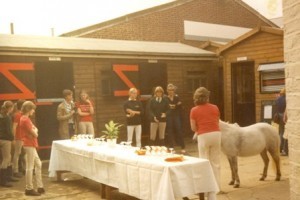
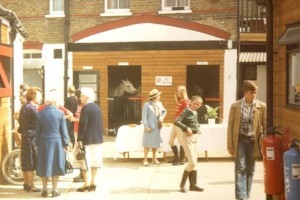
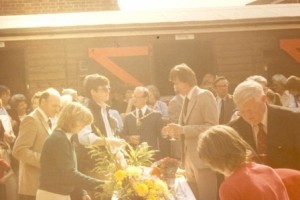
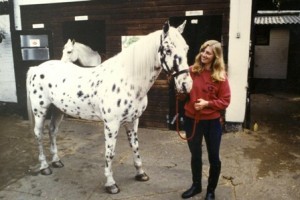 Carol’s father, Walter Stevenson (photo below from 1986), could often be seen riding Carlof, immaculately turned out and an excellent advertisement for the yard. Caroline Stevenson, now Chief Instructor at WVS and a friend of Carol’s since their Pony Club days, came to work at the stables in 1981 and in 1984 she married Carol’s brother Peter. Both of Carol’s daughters, Sasha and Stephanie, and Caroline’s daughter, Ella, have been riding since they were young and regularly compete, with Sasha enjoying great success on the much loved family horse Pod. The family tradition looks set to continue, as Carol’s granddaughters are already showing promise in the saddle. Dirga’s daughter Nadia has also followed in her mother’s footsteps and is currently a valued member of the WVS team. WVS can therefore truly be described as a family business, which adds to its charm and friendliness while in no way detracting from the professionalism exhibited by the WVS Team.
Carol’s father, Walter Stevenson (photo below from 1986), could often be seen riding Carlof, immaculately turned out and an excellent advertisement for the yard. Caroline Stevenson, now Chief Instructor at WVS and a friend of Carol’s since their Pony Club days, came to work at the stables in 1981 and in 1984 she married Carol’s brother Peter. Both of Carol’s daughters, Sasha and Stephanie, and Caroline’s daughter, Ella, have been riding since they were young and regularly compete, with Sasha enjoying great success on the much loved family horse Pod. The family tradition looks set to continue, as Carol’s granddaughters are already showing promise in the saddle. Dirga’s daughter Nadia has also followed in her mother’s footsteps and is currently a valued member of the WVS team. WVS can therefore truly be described as a family business, which adds to its charm and friendliness while in no way detracting from the professionalism exhibited by the WVS Team.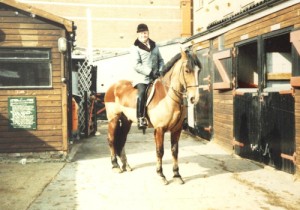
As well as running the yard, Carol and Caroline have been responsible for organising many other well-attended equestrian activities. Together they founded the Annual Sponsored Ride in 1975 and it is the oldest and most successful in the country. Although initially these fund raising events attracted riders from all over the country, since the 2016 foot and mouth outbreak, the sponsored rides have now only been open to WVS Members. Nevertheless, despite the smaller number of participants, the amount raised each year ranges from £10,000 to £20,000, a massive increase from the £550 raised in 1975.
From 1989, WVS organised a Summer Show by Rushmere Pond as part of the Wimbledon Village Fair and, over the years, hundreds of riders participated, both WVS liveries and clients as well as others from further afield. For various reasons, it was no longer viable to continue to hold the show and it was with great sadness that the last one took place in 2017.
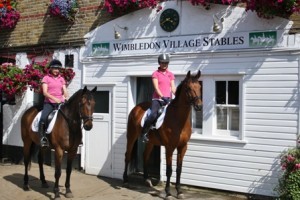 However successful WVS has been, Carol has always looked for ways to improve the business and, in 1999, she decided to establish a Members Club which increased the popularity of the stables still further. Membership ensures that frequent and committed riders can secure a regular slot at favourable rates, while the horses benefit from a more consistent routine. Membership also drove a desire for more social events and a quest for further understanding of all things equestrian. As a result, WVS started putting on a variety of educational events for Members and also organises activities such as celebrity talks, with well-known guest speakers, including Clare Balding, Mary King and Laura Collet.
However successful WVS has been, Carol has always looked for ways to improve the business and, in 1999, she decided to establish a Members Club which increased the popularity of the stables still further. Membership ensures that frequent and committed riders can secure a regular slot at favourable rates, while the horses benefit from a more consistent routine. Membership also drove a desire for more social events and a quest for further understanding of all things equestrian. As a result, WVS started putting on a variety of educational events for Members and also organises activities such as celebrity talks, with well-known guest speakers, including Clare Balding, Mary King and Laura Collet.
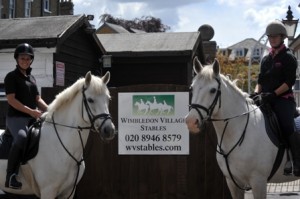
Another inspired development was the acquisition in 2016 of a horse simulator (the Equicise), which helps Members of all abilities to improve their riding and enjoy an even better experience when riding a real horse. It is a wonderful training aid for riders, enabling them to address bad habits, which is also beneficial for the horses. The Equicise is located in a purpose built studio, fully equipped with gym equipment and mirrors, encouraging riders to appreciate how much their riding will improve if they are physically fitter.
It is not only the riders who have benefited from the improvements that have been introduced at WVS over the years, as the horses also have access to the best professional treatments, from masseurs and physios to the recent acquisition of a Theraplate which uses vortex wave therapy to optimise the horses’ well being and a Solarium to enhance their health through advanced light therapy.
This is all in addition to the regular holiday breaks in the fields that every horse enjoys at Manor Farm in Claygate, where they are excellently looked after by Sandra and Amy Cullingham, another mother and daughter team.
With horse welfare its top priority, WVS is proud to have a strong association with World Horse Welfare (for which it has raised significant amounts of money) and even provided 10 horses to ride through central London from Hyde Park Barracks to the Houses of Parliament to promote a bill to stop the live transportation of horses.
WVS has always felt very privileged to be part of the Wimbledon Village Community and regularly provides horses for events such as the Christmas Parade on the Village Shopping Day. The WVS Annual Christmas Carol Concert is sold out within hours of tickets going on sale and is much loved by the hundreds of children who, together with their parents, have attended over the years. A social highlight for WVS Members, along with many Village people, is the Annual Charity Ball which, together with the Annual Sponsored Rides, is a key WVS fund raising activity. Indeed, over the years, WVS is proud to have helped to raise over £1,000,000 for a variety of very worthwhile causes and plans to build on this success in the future.
The arrival of COVID in 2020 was a threat not only to people, but also to many businesses, including several riding schools which were forced to close. WVS was able to survive thanks to the generosity and loyalty of its Members who came together to support the stables throughout all the lockdowns and related restrictions. In a time when everyone was feeling so isolated, the WVS team reinvented themselves as TV producers and made a weekly Zoom show for Members, many of whom have said that “The Saturday Show” was the one event that helped them get through each week. WVS was so grateful to their support that it had a plaque made which sits on the office wall to commemorate and thank all the “WVS Angels”.
WVS is delighted to be playing its part in the long story of the stables; over the past 44 years, it has welcomed riders who have been clients, liveries or Members for decades, including three generations of one family and a livery who has kept horses at WVS for nearly 40 years.
Thanks to the combination of quality horses, dedicated staff, beautiful riding country and its successful Membership scheme, WVS can look to the future with confidence.
Wimbledon’s first recorded horses in fact appear in the reign of King John’s son, Henry III. They belonged to the lord of the manor, the Archbishop of Canterbury. In his accounts for the years 1236-37, the Archbishop’s Bailiff (the official who managed his farm at the end of Church Road near St Mary’s) noted that he had two horses.
 The accounts for the 1270s show that the Bailiffs example had since been followed by some of the Archbishop’s tenants who now also owned horses. Instead of doing work in his fields, they were paying rent for their land not in money, but in horseshoes or in “strigils”, curry combs for grooming horses. So there is little doubt that they were already grazing their one or two animals on the Common. Then John Perkyn was fined for “overburdening the Common with six horses and mares”, four more than he was allowed. In 1488, all the tenants were ordered “to remove from the Common all mangy horses and mares”, an order often repeated in the next century.
The accounts for the 1270s show that the Bailiffs example had since been followed by some of the Archbishop’s tenants who now also owned horses. Instead of doing work in his fields, they were paying rent for their land not in money, but in horseshoes or in “strigils”, curry combs for grooming horses. So there is little doubt that they were already grazing their one or two animals on the Common. Then John Perkyn was fined for “overburdening the Common with six horses and mares”, four more than he was allowed. In 1488, all the tenants were ordered “to remove from the Common all mangy horses and mares”, an order often repeated in the next century.
By then stables and coaches had begun to appear at the chief houses in the village. In the 1550s William Cecil had a stable at the Rectory capable of taking 14 horses. By the early years of the next century his eldest son, Thomas first Earl of Exeter and builder of Wimbledon’s first manor house, owned several coaches, while his grandson, Edward, Viscount Wimbledon, escorted the coffin of his second wife to St Mary’s parish church “by night with a train of twenty carriages, drawn with six horses a piece and many more with four, and with torches without number”. It must have been an amazing sight.
Riders on the Common
As the numbers of such wealthy families living in Wimbledon increased, so their journeys to London on horseback or by coach became tempting targets for footpads and highwaymen. In the 1750s such robbers were said to “so infest” the Common “that ’tis dangerous travelling day or night”.
In the 1730s, it was the scene of an annual horse race for the King’s Plate. Sixty years later, during

William Pitt
the long war against Napoleon, it was also the training ground of a mounted “Home Guard”, the Wimbledon Volunteer Cavalry who, in colourful uniforms, paraded twice a week to prepare for a French invasion which fortunately never came.
By then, with the threat from highwaymen at last over, the Common was being used by riders whose chief interest was not travel, but exercise. Among them was the Prime Minister, William Pitt, who on his frequent visits to Cannizaro in the 1790s went for long rides with his host, Henry Dundas, the Secretary for War.
Village Blacksmith and Stables
The men who had the important job of caring for all these horses, those of the wealthy gentry as well as of the ordinary villagers, were the blacksmiths. The first whose name has been recorded was John Linton in 1617. His smithy was at “Long’s Corner” where the High Street joins Southside (and where today, very appropriately, the vet has his surgery). Not merely did he shoe horses, but like a vet tried to cure their ailments, as well as repairing ploughs and carts, and making farm implements.
Linton seems to have been law abiding, but one of his successors in Charles II’s reign, Tobias Barton, was frequently in trouble, accused of being “a common disturber of the peace” and “throwing a large quantity of dung into le Pond”. Nevertheless, the smithy remained at Long’s Corner until well into the twentieth century, while the blacksmiths from early in Queen Victoria’s reign began to describe themselves as “Smiths, Farriers and Vets”.
 All this time an increasing number of travellers had been passing through the village, especially after Putney Bridge was opened in 1729. To look after those who needed to stay the night, there were two main inns: the older Dog and Fox, and the Rose and Crown. Each had large stables for the horses. By the 1850s, these were being called livery stables (able to look after other horses than those of people lodging at the inn) and were run by a Job Master (ready to provide horses for hire).
All this time an increasing number of travellers had been passing through the village, especially after Putney Bridge was opened in 1729. To look after those who needed to stay the night, there were two main inns: the older Dog and Fox, and the Rose and Crown. Each had large stables for the horses. By the 1850s, these were being called livery stables (able to look after other horses than those of people lodging at the inn) and were run by a Job Master (ready to provide horses for hire).
Wimbledon’s First Riding Stables
The first person in Wimbledon to give riding lessons seems to have been William Cooke, who had recently been managing Astley’s famous circus near Westminster Bridge. He came here in 1866, took over the stables next to the Castle Inn in Church Road and advertised himself as Riding and Job Master.
When he died twenty years later, his son, also William, took over. Just before the First World War he transformed the stables into the Victoria Riding Establishment. Unfortunately his horses were then requisitioned by the Government for war service.
The Wimbledon Museum is a small, intimate museum where you will find, in pictures, words and objects, the 3000 year history of Wimbledon. 22 Ridgway, Wimbledon, London SW19 4QN. It is open at the weekend between 2.30pm and 5pm, admission is free.
Hilcote Riding School

William Kirkpatrick
The next recorded instructor was William Kirkpatrick, a Scotsman who trained racehorses for a wealthy banker. When his employer moved to London during the First World War, Kirkpatrick came with him, but soon came to believe that the future lay with riding rather than racing stables. So he gave up his job, moved to Wimbledon, leased a house at the end of Marryat Road and started a small riding stables. Shortly afterwards the much larger and more central Stables behind the Dog and Fox came on the market. He decided to take on the lease and there in 1919 set up the Hilcote Riding School, (now Wimbledon Village Stables) named apparently after the lady owner’s house in Lancaster Road.
The School was a success almost from the start. Mr Kirkpatrick did the instructing, helped at first by his brother (who then left and took over William Cooke’s old stables near the Castle Inn). He had a large staff of grooms, all men, and kept 35 to 40 horses in two stables. The main one was behind the Dog and Fox; a smaller one for the children’s ponies was some distance away in a mews opposite Grosvenor Hill. The horses were bought at Tattersall’s auctions in London or at Cambridge horse sales. They cost between sixty and eighty pounds each and had a normal working life of ten years. Every four weeks, grooms rode them down the Hill to the blacksmith’s in St Mark’s Place, near the library, to be shod.
Riders came in large numbers. Many were small boys and girls who paid five shillings an hour and were instructed in two riding rings, the Black Ring near the Roman Well Laundry on the Common and the Sandy Ring near the Richardson Evans Playing Fields by the Robin Hood Gate to Richmond Park. But the great majority of the riders were men, often wealthy businessmen like Richard Seligman of Lincoln House, Parkside, and Alfred Faulkner, a tobacco “baron” who owned a huge house a little nearer Putney. Such people had the horses brought to their house by one of the grooms. Even more select was Roy Lancaster, head of the “Pru”. He owned a coach and four, which was looked after by the Stables and kept in a nearby garage. Every summer he took it out and drove to Epsom for the races.
The outbreak of the Second World War in 1939 nearly ruined Hilcote Riding School. The horses were not requisitioned as in 1914, but the number of people wanting to ride shrank, especially at the time of the Battle of Britain and there was a constant problem of getting enough food for the horses. Their survival was ensured by the Stables agreeing to look after the Carleton Bakery horses,

Cal McCord
which gained them horse feed from a corn merchant on Wimbledon Hill, as well as pigswill collected from bins at street corners.
Later, as the threat of raids receded (and the Morrison shelter in the saddle room was no longer needed), the Stables gained new customers, American officers preparing for the invasion of Europe. Among them was the famous cowboy, Cal McCord, who rode regularly on the Common.
After the War, the Stables soon revived. But then William Kirkpatrick died and his daughter Jean, who had already taken over, had a serious riding accident. Confined to a wheelchair she continued to supervise the running of the stables from the office, and even managed to do some teaching aided by a carer and with the help of a car.

In 1964 in stepped Colin Crawford, a local businessman, known jokingly as ‘The Squire of Wimbledon’ who at first just liveried a pony called ‘Lucky Jimmy’ for his son Keith to learn to ride on. Having ridden throughout his life, he then bought a horse for himself, ‘Melody Fair’, a beautiful skewbald mare. Unknowingly, this would change the long term course of his life and the stables once again.

Colin Crawford, Jean Kirkpatrick and Michael Simons MRCVS
By the end of the Sixties, Colin was virtually overseeing the day to day running of the stables. Jean Kirkpatrick, although mentally a resoundingly strong woman, found it difficult to run the stables alone. Colin by now had his mare, Melody Fair plus Lucky Jimmy’s replacement Nobby a thirty five year old pony he bought for £60 in 1965 for his daughter Jenny to learn to ride on. With Lucky Jimmy being retired through laminitis, Keith and Jenny shared Nobby between them. Every free moment was spent at the stables or going to shows.

Oliver Reed
By 1969 Colin’s own first marriage had broken down; coincidentally, around this time the family linen business in Ireland was sold. Free to do what he liked, Colin agreed to take over the lease and running of the stables full time. The actor Oliver Reed, a good friend of Colin’s, kept his horse Dougal at livery at the yard. Colin met his second wife, Judith a cousin of Oliver’s through Dougal. Judith would come up occasionally to ride him. ‘The Squire’ was a good looking chap to whom Judith took a shine. Sharing a passion for horses, they later married in 1972.
Throughout the early 70s Jean continued to live with her carer in the flat above the yard till the mid seventies when she sadly had to move into assisted housing because of her paralysis. Colin had tried to purchase the stables outright from Jean throughout this time, but to no avail: Jean would not sell.
In 1978, Colin and Judith wanted to purchase their own stables, and so bought ‘April Cottage’ in Walton on the Hill, complete with a yard comprising thirty-plus boxes and some land. Colin by this time was tiring of life in Wimbledon and was happy to move. He was more content out on the hunting field anyway. A full member of the Surrey Union Hunt, Saturday and Wednesday would find him at full hue and cry, usually taking the odd hireling or two along for the thrill. Having lived a long time at Wimbledon, they sold their house off the Ridgway and moved to Surrey. Having both yards during 1979 proved to be too much, although they had installed a manager at Hilcote, things just weren’t the same.
By the end of the year Colin had totally lost interest and decided to give Hilcote up to concentrate full-time on his new yard. It was to be ironic, that, having declared for years that she wouldn’t sell the yard, with Colin now gone, Jean Kirkpatrick did exactly that. She put the stables on the market.
The New Wimbledon Village Stables
 In December 1979, the yard was put up for sale. Aylesford, who was asked to manage it, stated at first: “We are not exactly sure how to value the site. It’s not every day that a stables comes up for sale”. However, by the start of 1980 it was put on the market, though Aylsford conceded that the buildings were in need of “extensive repair work”.
In December 1979, the yard was put up for sale. Aylesford, who was asked to manage it, stated at first: “We are not exactly sure how to value the site. It’s not every day that a stables comes up for sale”. However, by the start of 1980 it was put on the market, though Aylsford conceded that the buildings were in need of “extensive repair work”.
Soon five rival groups were bidding for the site, among them Merton Council, which was planning to build a multi-storey car park there. In the end, the “battle” was won by the group composed of Walter Stevenson and his wife, their daughter, Carol, and Peter Strong and his wife, Dirga. Carol and Dirga had met as young girls in 1968 at Coombe Hill Stables and became firm friends, together owning a really striking and somewhat unusual spotted horse (aptly named Spotty). He originally came from a circus and, as well as his eye-catching colour, he also had very extravagant paces, leading some to suspect that he might have been part Hackney. The two girls had often imagined owning a riding school, so were understandably excited when they were able to fulfil their childhood dream.
They carried out “a massive renovation”, replacing the rotten wooden stalls and hay barns with prefabricated stalls, four new loose boxes, an office and a staff room.
On 23 August 1980, there was a grand opening ceremony of the renamed Wimbledon Village Stables by the Mayor of Merton, Tom Bull. As well as Spotty, there were 11 new horses, including an ex-stunt horse Rasputin, a 19 year old Russian, Florrie, a seven year old Shetland pony, and a young thoroughbred mare called Dream Days (Dreamer) who was not only a very popular horse in the riding school, but also won many prizes eventing and show jumping. In her later years, Dreamer produced three beautiful foals, the youngest of which, Pod, spent most of his life at WVS and lived to the grand age of 30. With such reliable horses, the new stables got off to “a flying start”. Most of the weekend rides were soon fully booked and weekday rides were also popular. Only two years after the opening in 1982, The Horse and Pony magazine voted it “the top stables in London for its well kept horses, efficient administration and good teaching”.



 Carol’s father, Walter Stevenson (photo below from 1986), could often be seen riding Carlof, immaculately turned out and an excellent advertisement for the yard. Caroline Stevenson, now Chief Instructor at WVS and a friend of Carol’s since their Pony Club days, came to work at the stables in 1981 and in 1984 she married Carol’s brother Peter. Both of Carol’s daughters, Sasha and Stephanie, and Caroline’s daughter, Ella, have been riding since they were young and regularly compete, with Sasha enjoying great success on the much loved family horse Pod. The family tradition looks set to continue, as Carol’s granddaughters are already showing promise in the saddle. Dirga’s daughter Nadia has also followed in her mother’s footsteps and is currently a valued member of the WVS team. WVS can therefore truly be described as a family business, which adds to its charm and friendliness while in no way detracting from the professionalism exhibited by the WVS Team.
Carol’s father, Walter Stevenson (photo below from 1986), could often be seen riding Carlof, immaculately turned out and an excellent advertisement for the yard. Caroline Stevenson, now Chief Instructor at WVS and a friend of Carol’s since their Pony Club days, came to work at the stables in 1981 and in 1984 she married Carol’s brother Peter. Both of Carol’s daughters, Sasha and Stephanie, and Caroline’s daughter, Ella, have been riding since they were young and regularly compete, with Sasha enjoying great success on the much loved family horse Pod. The family tradition looks set to continue, as Carol’s granddaughters are already showing promise in the saddle. Dirga’s daughter Nadia has also followed in her mother’s footsteps and is currently a valued member of the WVS team. WVS can therefore truly be described as a family business, which adds to its charm and friendliness while in no way detracting from the professionalism exhibited by the WVS Team.
As well as running the yard, Carol and Caroline have been responsible for organising many other well-attended equestrian activities. Together they founded the Annual Sponsored Ride in 1975 and it is the oldest and most successful in the country. Although initially these fund raising events attracted riders from all over the country, since the 2016 foot and mouth outbreak, the sponsored rides have now only been open to WVS Members. Nevertheless, despite the smaller number of participants, the amount raised each year ranges from £10,000 to £20,000, a massive increase from the £550 raised in 1975.
From 1989, WVS organised a Summer Show by Rushmere Pond as part of the Wimbledon Village Fair and, over the years, hundreds of riders participated, both WVS liveries and clients as well as others from further afield. For various reasons, it was no longer viable to continue to hold the show and it was with great sadness that the last one took place in 2017.
 However successful WVS has been, Carol has always looked for ways to improve the business and, in 1999, she decided to establish a Members Club which increased the popularity of the stables still further. Membership ensures that frequent and committed riders can secure a regular slot at favourable rates, while the horses benefit from a more consistent routine. Membership also drove a desire for more social events and a quest for further understanding of all things equestrian. As a result, WVS started putting on a variety of educational events for Members and also organises activities such as celebrity talks, with well-known guest speakers, including Clare Balding, Mary King and Laura Collet.
However successful WVS has been, Carol has always looked for ways to improve the business and, in 1999, she decided to establish a Members Club which increased the popularity of the stables still further. Membership ensures that frequent and committed riders can secure a regular slot at favourable rates, while the horses benefit from a more consistent routine. Membership also drove a desire for more social events and a quest for further understanding of all things equestrian. As a result, WVS started putting on a variety of educational events for Members and also organises activities such as celebrity talks, with well-known guest speakers, including Clare Balding, Mary King and Laura Collet.

Another inspired development was the acquisition in 2016 of a horse simulator (the Equicise), which helps Members of all abilities to improve their riding and enjoy an even better experience when riding a real horse. It is a wonderful training aid for riders, enabling them to address bad habits, which is also beneficial for the horses. The Equicise is located in a purpose built studio, fully equipped with gym equipment and mirrors, encouraging riders to appreciate how much their riding will improve if they are physically fitter.
It is not only the riders who have benefited from the improvements that have been introduced at WVS over the years, as the horses also have access to the best professional treatments, from masseurs and physios to the recent acquisition of a Theraplate which uses vortex wave therapy to optimise the horses’ well being and a Solarium to enhance their health through advanced light therapy.
This is all in addition to the regular holiday breaks in the fields that every horse enjoys at Manor Farm in Claygate, where they are excellently looked after by Sandra and Amy Cullingham, another mother and daughter team.
With horse welfare its top priority, WVS is proud to have a strong association with World Horse Welfare (for which it has raised significant amounts of money) and even provided 10 horses to ride through central London from Hyde Park Barracks to the Houses of Parliament to promote a bill to stop the live transportation of horses.
WVS has always felt very privileged to be part of the Wimbledon Village Community and regularly provides horses for events such as the Christmas Parade on the Village Shopping Day. The WVS Annual Christmas Carol Concert is sold out within hours of tickets going on sale and is much loved by the hundreds of children who, together with their parents, have attended over the years. A social highlight for WVS Members, along with many Village people, is the Annual Charity Ball which, together with the Annual Sponsored Rides, is a key WVS fund raising activity. Indeed, over the years, WVS is proud to have helped to raise over £1,000,000 for a variety of very worthwhile causes and plans to build on this success in the future.
The arrival of COVID in 2020 was a threat not only to people, but also to many businesses, including several riding schools which were forced to close. WVS was able to survive thanks to the generosity and loyalty of its Members who came together to support the stables throughout all the lockdowns and related restrictions. In a time when everyone was feeling so isolated, the WVS team reinvented themselves as TV producers and made a weekly Zoom show for Members, many of whom have said that “The Saturday Show” was the one event that helped them get through each week. WVS was so grateful to their support that it had a plaque made which sits on the office wall to commemorate and thank all the “WVS Angels”.
WVS is delighted to be playing its part in the long story of the stables; over the past 44 years, it has welcomed riders who have been clients, liveries or Members for decades, including three generations of one family and a livery who has kept horses at WVS for nearly 40 years.
Thanks to the combination of quality horses, dedicated staff, beautiful riding country and its successful Membership scheme, WVS can look to the future with confidence.
